Art World
Artist Q & A with Zhang Xiaogang
Heather Russell sits down with Chinese contemporary artist Zhang Xiaogang.
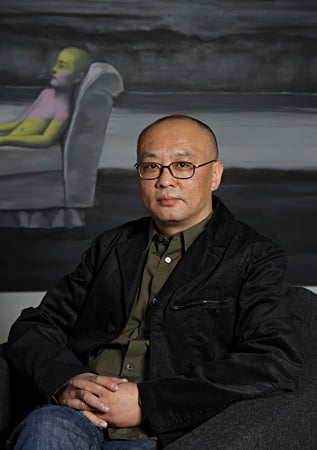
Heather Russell sits down with Chinese contemporary artist Zhang Xiaogang.

Heather Russell


Zhang Xiaogang, photograph by G.R. Christmas, courtesy Pace Gallery
Heather Russell: Your current exhibition at Pace New York features mostly sculptures. How did you become interested in this medium?
Zhang Xiaogang: First of all, I don’t see these pieces as sculptures, but rather as three-dimensional paintings. Secondly, my concept for this exhibition has gone through some changes due to a long period of planning. My initial idea to integrate paintings and sculpture works started five to six years ago.

Zhang Xiaogang, White Shirt and Blue Trousers, 2012, oil on canvas, 55 1/8 x 78 3/4 in., photo by Yang Chao / Courtesy Pace Gallery
HR: How long did it take you to make the sculptures for this exhibition? Can you explain the process to us?
ZX: Three years. However, I started experimenting with sculptures in 2007, and held a few small exhibitions between now and then. At first it was just a simple idea to integrate these two media. After I consulted with several sculpture experts, I realized that the concept of the work itself is more important than the medium. In 2008, I displayed two small sculptural pieces in New York.
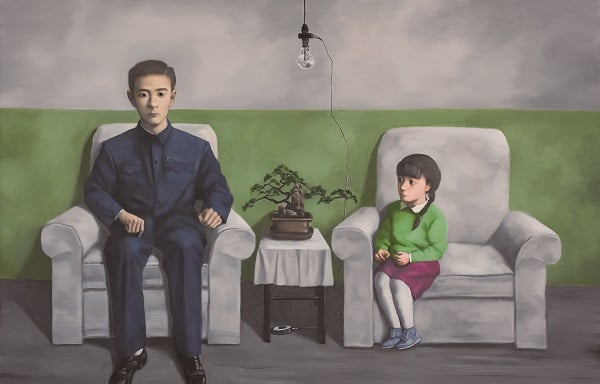
Zhang Xiaogang, My Father, 2012, oil on canvas, 55 1/8 x 86 5/8 in., photo by Wang Xiang / Courtesy Pace Gallery
HR: What was the academic and collector response to these two works?
ZX: There was not a lot of reaction. At the time, people were focusing on my Bloodline family portraits.
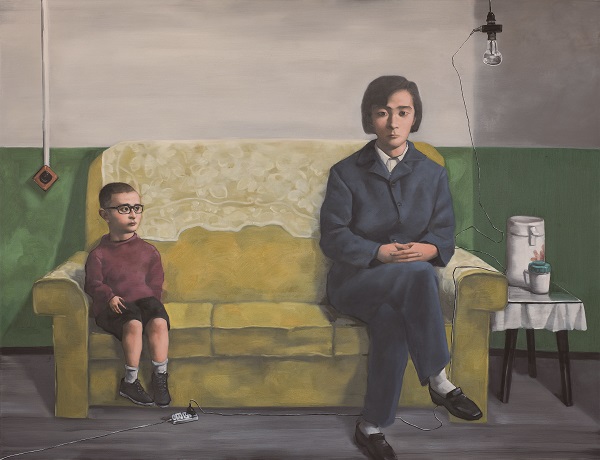
Zhang Xiaogang, My Mother, 2012, oil on canvas, 6 feet 6 3/4 inches x 8 feet 6 3/8 inches, photo by Wang Xiang / Courtesy Pace Gallery
HR: Your paintings have received international acclaim. What motivated you as an artist to focus on a new medium at this point in your career?
ZX: My interest in sculpture goes back to 2008. In 2009, I held a large-scale exhibition in Beijing, and created 60 new sculptures of everyday objects, each on its own pedestal. All of these domestic objects I selected to sculpt—a telephone, eyeglasses, an ashtray—are related to my personal life; I even wrote down my thoughts at the time on some of these objects in white paint. From then on, I felt a connection with media outside of canvases. Heather flips through Zhang’s catalogue for The Record.
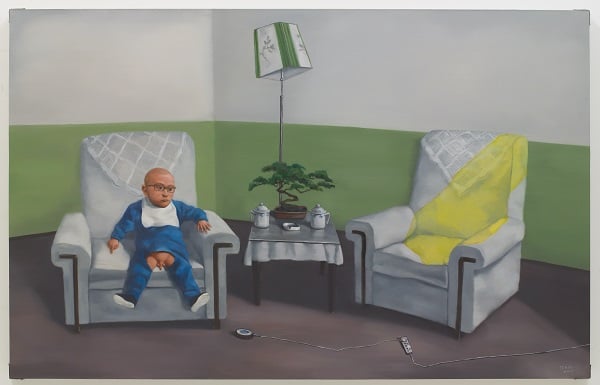
Zhang Xiaogang, The Position of Father, 2013, oil on canvas, 55 1/2 x 86 5/8 in., photo courtesy Pace Gallery
HR: I see some of your earlier works on paper and paintings are Conceptual. Do you think these pieces can possibly lead to Installation Art in the future?
ZX: I don’t think about the future, as I just want to make sure that I grasp my feelings today.

Zhang Xiaogang, Young Woman, 2013, painted bronze, 89 1/16 x 36 x 36 in. overall installed, Cast of 3, Edition of 3 + 1 AP, photograph by Kerry Ryan McFate / courtesy Pace Gallery
HR: I noticed that your paintings are exhibited in one gallery at Pace, and your sculptures are exhibited in the other. Why did you choose to show them separately?
ZX: Three paintings were created and shown in a previous exhibition last year in Beijing. The initial idea for this exhibition was to just show sculptures. However, the exhibition space at Pace was very large, and so the gallery decided to add these paintings.
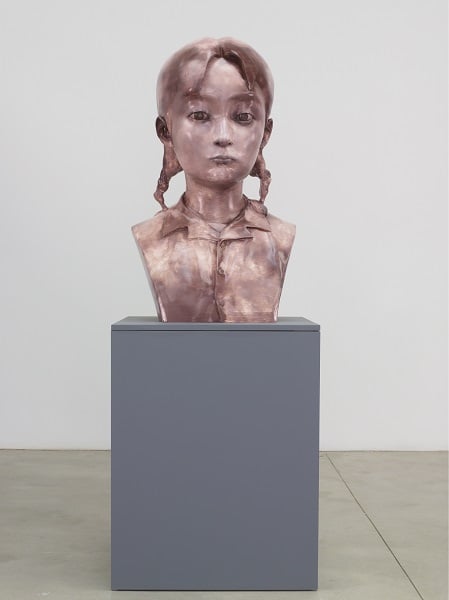
Zhang Xiaogang, Young Girl No. 3, 2013, painted bronze, 78 1/2 x 28 x 28 in. overall installed, Cast of 3, Edition of 3 + 1 AP, photograph by Kerry Ryan McFate / courtesy Pace Gallery
HR: Do you think that people react differently to your paintings than to your sculptures? If so, why do you think they do?
ZX: I didn’t hear much about my paintings after this exhibition, because three of the four works have already been shown in the Beijing exhibition.
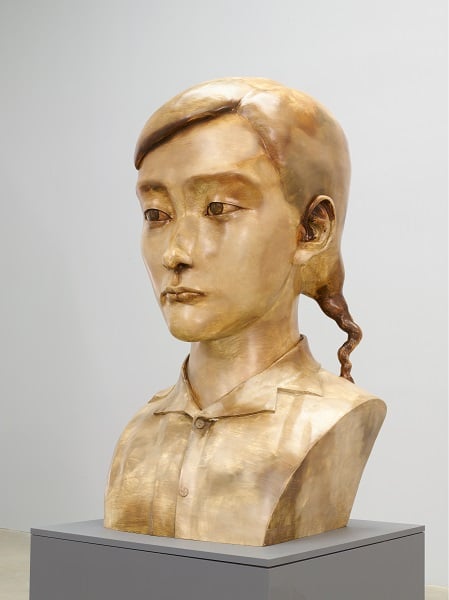
Zhang Xiaogang, Young Woman, 2013, painted bronze, 89 1/16 x 36 x 36 in. overall installed, Cast of 3, Edition of 3 + 1 AP, photograph by Kerry Ryan McFate / courtesy Pace Gallery
HR: Did anybody touch the sculptures, to explore what it was made of?
ZX: I didn’t notice anyone touching the sculptures. But I did realize that the paint on the bronze changed the perception of the material.
HR: Why are you using bronze and the colors you selected, some very quiet and some vibrant, on the surface of the works?
ZX: I really like bronze as a material. At first I wanted to make the sculpture pieces in Beijing, but the result wasn’t that great after experimentation, so we shipped everything to New York, and used the best bronze casting foundry there. I only had an initial, rough idea back in Beijing. Then, I wanted to make the sculptures look and feel like paintings, instead of pure sculptures. Through painting on the surface, the sculpture was altered, producing unique works. I found a lot of inspiration after I came to New York; I was inspired by the colors, and by the use and treatment of texture. This exhibition is a result of working and living in both cities, Beijing and New York.
HR: How does your time living and working in the West affect your work?
ZX: Since it’s my first time living and working in New York for such a long period of time, it’s been a fresh experience. I don’t feel as comfortable here as Beijing because of unfamiliarity, but I have been inspired by the new environment.
HR: Do you find that collectors in the East versus those in the West respond differently to your work?
ZX: Based on my experiences, western collectors have been first and foremost interested in the art ideology and art languages, and then they want to find out about the future market value. However, the eastern collectors are mostly attracted by the future value of my works, as they are more accustomed to the ideology.
HR: How do you feel about people seeing your art as a commodity? Does it affect you in any sense?
ZX: I’m very happy and thankful to those that buy my works. However, it shouldn’t affect an artist in any way because I see the market as very separate from the creation of art. However, the Chinese market has changed and imposed a lot of requirements for art, which creates challenges for young artists. I remember when I was younger, exhibitions didn’t exist, and people didn’t want to sit down and listen to you talk about art. I was still happily working because I love art; but today, some people treat creating art merely as a job.
HR: What are you currently working on?
ZX: I don’t know yet, it depends on my feelings and inspiration.
HR: The four paintings you are showing at Pace take a different turn from earlier paintings. Can you explain the rationale behind this?
ZX: My inspirations for this series go back to 2010 and 2012, and the idea to explore two different kinds of memories. One kind of memory that I explore relates to my feelings of childhood, exploring father-son and father-daughter relationships; another kind is memories of revolution and history, represented by the plum blossoms in the paintings. My mother passed away in 2010, and it really affected me. I tried to go back to these early memories as a child, remembering what it was like looking up at my parents back then. I altered the scale between child and mother to reflect what it was like for a child to look at adults. I also wanted to reflect complex feelings in My Mother, which was related to my personal experiences. In My Father, the little girl represents me as a child looking at my father, and also represents myself as a father and my relationship with my daughter.
HR: It is apparent that photography has had a major influence on your work, specifically photographs of your family when you were a child. When you take family portraits now, do you see a resemblance and/or difference from the photographs that inspired your current work?
ZX: There is a big difference. It’s a different era, and people’s relationships have changed dramatically. It’s very easy to take a picture now with the technology we have, so people are in a relaxed state while having their photographs taken. However, it was not easy back when I was a child. My parents tried to incorporate a lot of things, such as their understanding about life and their aesthetics, into family photographs, so these pictures came out very different.
HR: Pace will be showing your work at Art Basel HK this year. What can we expect to see from you there?
ZX: I will definitely show new works there, but the gallery has not yet decided whether to put up my sculptures or paintings.
Zhang Xiaogang runs from March 29 to April 27, 2013, at Pace Gallery, 508 and 510 West 25th Street, New York, NY.
This interview was originally conducted in Chinese, and was translated by Jessica Zhang, marketing associate at artnet. Click here to read the Chinese version.
All Artwork: © Zhang Xiaogang / Courtesy Pace Gallery